A Guide for Woodworkers, Cabinet Makers, Remodelers and Beginning Fabricators
Are you a woodworker, remodeler or cabinet maker? Have you ever built, or wanted to build, countertops or shower enclosures from Corian® or other brands of solid surface material? If not, what’s holding you back?
- Have you felt daunted by the cost of equipment needed to start fabricating countertops and shower walls?
- Were you unaware that working with solid surface is like working with hardwoods?
- Perhaps you didn’t realize that solid surface material seams together invisibly, doesn’t require a finish and can be renewed if blemished—making your job infinitely easier!
Ok, so the last two points might sound a little salesy, but speaking to a capable woodworker, we REALLY wanted to drive home the beneficial qualities of solid surface right up front. The facts are: solid surface is an amazing medium to work with, it can be quite inexpensive to get started and it’s highly likely you won’t even end up incurring additional tooling costs.
Although it’s very rewarding material to work with, we recommend that you hire a local solid surface fabricator for complex projects. Ever changing legal code requirements and physical production safety elements, make subcontracting out an increasingly attractive option. Professional fabricators, like with any fine craft, have years of specialized experience and an in-depth knowledge of working with the tools and solid surface material, which can ultimately save you time and give you the confidence that your job will get done right.
In the next few paragraphs we’ll outline some of the minimum tools required to get started fabricating solid surface countertops, wet walls, furniture, or other projects. The good news is, since you already work with wood, it’s likely y have many—if not all—of the tools needed. We’ll also discuss some of the higher end tools that you may want to employ one day in order to fabricate more efficiently.
Please note that this is not intended to be an instructional guide, as we offer other exceptional beginner instructional material for working with solid surface, including tips and techniques from the pros.
Overview:
Working with solid surface is a four-stage process consisting of cutting, gluing, shaping and finishing. Professional installers typically have a mix of inexpensive and expensive tools they use at each stage of the fabrication process. This is usually determined by the shop owner or worker’s personal preference and\or budget restrictions.
You will be able to successfully fabricate solid surface on a shoestring budget using the tools discussed below. Or, with more spending flexibility, you can mechanize and computerize your operation so machines do more of the work with more precision, speed and cost effectiveness. In actuality, it’s a continuum from least expensive to more expensive and there are many combinations of hands-on tools and automated tools available in between.
Shoestring Budget:
The tools recommended on the lesser expensive end of the spectrum include: skill saw, jig saw, router, random orbit sander, drill, hot melt glue gun, straight edge (for rip fence), bar and spring clamps, templates and adhesive dispensing gun.
Big Budget:
Larger budgets allow for more efficient tools. Using more specialized tools will allow you to fabricate solid surface more quickly, precisely and with minimal human input when compared to using the tools available on a shoestring budget. These include, high precision wall saws, CNC routers (computer controlled cutting machines), v-groovers, seam setters, pneumatic adhesive dispensing guns, large format sanders and polishers.
Now, let’s compare the tools for each stage of fabrication:
Tools for Cutting (saws & routers)
The first step in solid surface fabrication, after the design is complete and material has been ordered, is almost always going to be cutting the material. Whether you’re making rough cuts, precision cuts, mirror cuts for seaming, or uniquely shaped cuts, there are great tools out there for the job. Chances are, you already have the tools you need to get started.
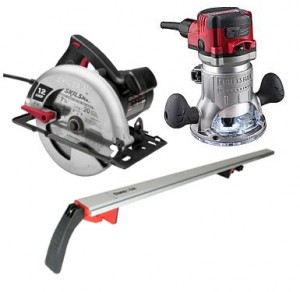
At a minimum, you’ll want to have a skill saw, router and fence for creating a straight edge. Jig saws, for cutting curves, are also great to have in your ‘toolbox’. With these tools, you can accomplish much of what needs to be done to fabricate in solid surface on a shoestring budget.
If your budget allows, or you have high-volume production, a high-precision vertical wall saw can make your life easier by making straight and clean cuts that are ready for seaming. This would take the place of the skill saw, router and rip fence.
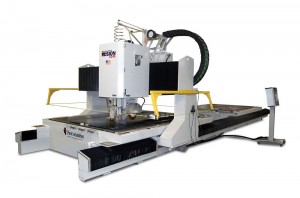 At the most expensive level, a CNC saw, router, or water jet can replace the jigsaw, template, router and rip fence for creating straight and curved pieces. Using CNC equipment requires training, maintenance and possibly an additional employee to operate the machine.
At the most expensive level, a CNC saw, router, or water jet can replace the jigsaw, template, router and rip fence for creating straight and curved pieces. Using CNC equipment requires training, maintenance and possibly an additional employee to operate the machine.
Tools for Gluing / Adhesive Step
Once the material has been cut to the desired size and the edges you intend to seam have been prepared properly, it’s time to break out the adhesive. Our SolidSurface101 article provides more detailed instruction on how to glue and seam solid surface for various applications.
As for the required tooling, you’ll need three things: adhesive and mixing tips, an adhesive applicator gun, and tooling to hold the material together while the adhesive sets for approximately 20 minutes. As you will see below, there are different categories that cover the the minimum tooling required, minimizing expense, as well as tools professionals use.
Adhesives
Adhesives have two components, that when mixed in the mixing tip, set in approximately 20 minutes. The industry standard adhesive tube size is 250 ml and there are several comparable brands available in the market. SolidSurface.com offers Integra Adhesive and Sta’-Put Adhesive (formerly Plexus) as of this writing.
The primary advantage that professionals have is that they qualify for volume pricing when they purchase frequently or in bulk.
Adhesive Applicator Guns
Nearly every solid surface adhesive on the market will require an adhesive gun and mixing tips to properly mix and dispense the two-part adhesive to ensure the most effective bond. There are essentially two types of guns—a manual gun and a pneumatic gun.
Manual solid surface adhesive dispensing guns vary in price and durability. The lower cost guns are typically for limited use situations or for situations where the professional users are careless with the guns and need to replace them frequently. They come in metal and plastic versions (opinions vary on which is better). Compact, light weight and durable seem to be three factors that many users agree are important. The metal gun shown left is designed to provide these three characteristics.
In the early days of fabrication, the MixPac DM200 was one of the few options available. Some fabricators continue to use this gun, to this day, even though it is often four times more expensive than metal guns. These die-hard fans and users swear by it!
High volume shops may use pneumatic guns, which provide consistent flow and little to no physical stress on the worker.
Adhesive Seam Setting Tools
Before applying the adhesive, it’s critical to put in place the device that will allow you to pull the two pieces of material together and hold them until the adhesive has cured (about 20 minutes.) As usual, there are many different ways to accomplish this on the low and high cost ends of the continuum. Also, as stated above, we go into much more detail in our seaming and gluing solid surface instructional material for the clamp and block method.
At the most basic level, you can use some small wood blocks, a heat glue gun and inexpensive clamps, to hold the material securely together. It’s important to note, when using this method you need to be sure the two pieces come together so the top surfaces are on the same plane. This can be done by adding shims under the surface where it rests on the support table cross pieces.
A solid surface seamer is a much more specialized tool that effectively keeps the two top surfaces on the same plane. This device sticks to the solid surface tops with suction cups and uses either a ratchet mechanism or a vacuum to pull the two pieces together, while leveling at the same time.
To really streamline the seam setting operation, you can utilize a vertical seam setter table, like the one pictured to the left.
After the adhesive has cured and you remove your tools holding it together, you may notice a hard bead of squeezed out glue on your seam. If this happens, don’t worry, as this is normal. As we explain in our instructional guides, any hardened glue beads left behind can be easily routed or sanded off.
Tools for Edge Build-Up
Building up the edge is a way to make the countertop look thicker without adding extra weight or cost. There are several ways to accomplish this look, depending on the tools you use.
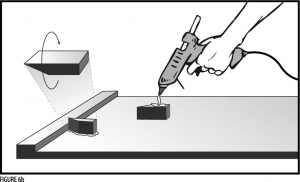
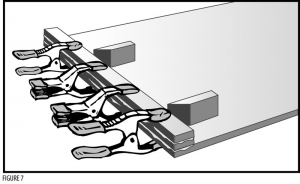 The most typical and least expensive way to achieve this look is to cut approximately 1” wide strips from the sheet of solid surface and then stack and glue them under the edge to the desired thickness (three layers thick, or 1.5″, is pretty typical.) As shown in the picture, you’ll also need color-matched adhesive, an adhesive gun, a hot melt gun, backing blocks and spring clamps. You can complete the finished edge treatment with a router and a decorative or straight edge router bit. We go into much more detail on this technique in our instructional guide, How to Build-Up Edges and Treat Corners of Solid Surface Countertop.
The most typical and least expensive way to achieve this look is to cut approximately 1” wide strips from the sheet of solid surface and then stack and glue them under the edge to the desired thickness (three layers thick, or 1.5″, is pretty typical.) As shown in the picture, you’ll also need color-matched adhesive, an adhesive gun, a hot melt gun, backing blocks and spring clamps. You can complete the finished edge treatment with a router and a decorative or straight edge router bit. We go into much more detail on this technique in our instructional guide, How to Build-Up Edges and Treat Corners of Solid Surface Countertop.
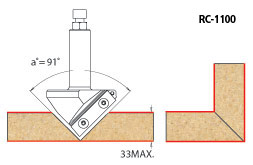
More recently, a miter fold edge has come into use for creating dropped edges. To create this style of edge, cut a “V” groove from the backside of the sheet, as shown in the image below. Next, place adhesive in the cut and fold and tape the edge into position until the adhesive hardens. You can also use a router with a straight edge rip fence to keep costs low.
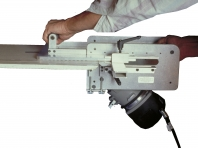
The next step up, in ease of use, would be the Betterly “V” grooving router, which costs around $1,500.
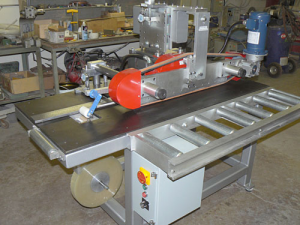
Beyond that, “V” grooving hardware is available. This hardware costs into the thousands of dollars, but is fast, easy and designed for heavy use.
The advantage to the miter fold (v groove) is the reduced time and effort required to give Corian® or other solid surface countertops a thicker, bolder, appearance.
Tools for Sink Installation
The tools needed for sink installation are pretty much the same, no matter what style of sink you are installing. However, the router bits you use can vary.
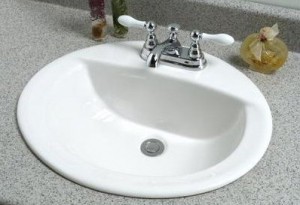 Drop in sinks require you to cut a hole big enough to drop in the sink. This typically requires a drill for a starter hole and a jig saw or router with a template.
Drop in sinks require you to cut a hole big enough to drop in the sink. This typically requires a drill for a starter hole and a jig saw or router with a template.
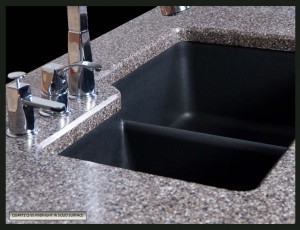 Standard undermount sinks—typically made of stainless steel, acrylic solid surface, stone and porcelain—can be installed with silicone and a router using a template. You can also use the sink itself as a guide, along with a nylon bearing router bit. More detailed instructions for installing these types of sinks can be found in our instructional guide, How To Install Undermount Sinks: Stainless Steel, Stone, & Porcelain.
Standard undermount sinks—typically made of stainless steel, acrylic solid surface, stone and porcelain—can be installed with silicone and a router using a template. You can also use the sink itself as a guide, along with a nylon bearing router bit. More detailed instructions for installing these types of sinks can be found in our instructional guide, How To Install Undermount Sinks: Stainless Steel, Stone, & Porcelain.
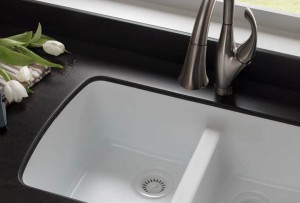 Seamless undermount sinks offer a great seamless look, are very easy to clean and are the most sanitary option. To install a seamless undermount sink you will need a router and two different bits: a straight bit with an oversize nylon bearing at the end and a roundover bit with a nylon bearing. The images below give an illustration of how this is done, but more detailed instruction can be found at How To Install a Seamless Undermount Solid Surface Sink.
Seamless undermount sinks offer a great seamless look, are very easy to clean and are the most sanitary option. To install a seamless undermount sink you will need a router and two different bits: a straight bit with an oversize nylon bearing at the end and a roundover bit with a nylon bearing. The images below give an illustration of how this is done, but more detailed instruction can be found at How To Install a Seamless Undermount Solid Surface Sink.
On the pricier side, CNC machines as described in the cutting section, can be used to make the rough sink cut-out for any of the methods listed above. Otherwise, a router is typically the tool of choice for most sink installations.
Finishing Tools
To place the final finish on your project—ranging from matte, to high-gloss—you’ll need a sander, some sandpaper and possibly buffing discs and compound. As with everything else, there are several options. If you are fortunate, you probably already have a random orbit sander you cherish. If so, this is an excellent option to use to put the finishing touches on your masterpiece!
Sandpaper / Finishing Kits
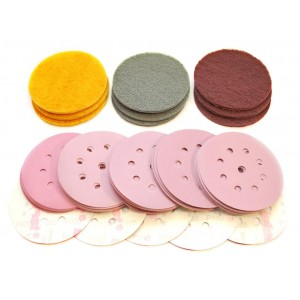
Whether you are a beginner or a seasoned professional, you will need to use a series of sand paper of varying grits to get the job done. The size and type of sander you have will determine the size and type of sandpaper you need. SolidSurface.com provides a variety of solid surface sand paper kits along with finishing tips and sanding sequence guides to help guide you in the process.
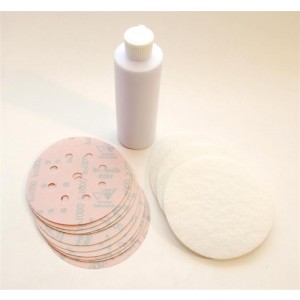 If you are looking to achieve a semi-gloss or gloss finish, you’ll want to pick up the appropriate buffing pad and compound. We have matte to gloss finishing kits available as well. Of course, larger sanders will require larger sandpaper discs.
If you are looking to achieve a semi-gloss or gloss finish, you’ll want to pick up the appropriate buffing pad and compound. We have matte to gloss finishing kits available as well. Of course, larger sanders will require larger sandpaper discs.
Sanders
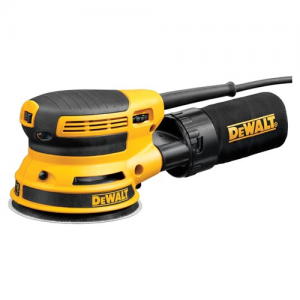 Your typical 5” or 6” orbital sander will work great at this stage! It’ll just take a little more elbow grease to get the job done, over the other more expensive options.
Your typical 5” or 6” orbital sander will work great at this stage! It’ll just take a little more elbow grease to get the job done, over the other more expensive options.
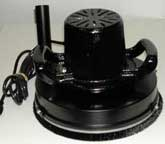
However, if you want to cover more area in a shorter amount of time, you can use a larger format sander like the 11” Gem random orbit sander pictured to the left.
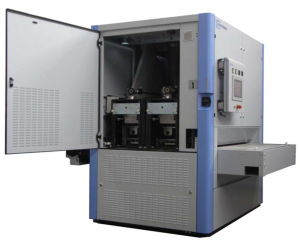 A large-scale orbital sander (like the one shown left) can be used to really step up the production process. By placing several of these in a row, you can sand a piece of material with the requisite succession of grits to achieve the desired finish. Image courtesy Stiles Machinery
A large-scale orbital sander (like the one shown left) can be used to really step up the production process. By placing several of these in a row, you can sand a piece of material with the requisite succession of grits to achieve the desired finish. Image courtesy Stiles Machinery
Tools For Advanced Techniques
Coved Backsplash
Creating a coved backsplash is a stylish, sanitary, and practical backsplash application. It is also an economically viable option. Presently, there are a number of ways to achieve a coved backsplash, within any budget. You can explore various tooling options by visiting our online guide to creating a coved backsplash.
Thermoforming
Employing thermoforming is an excellent way to raise the bar on the aesthetic design appeal of any project. The ability to thermoform solid surface—turning it into a flexible rubber-like material—makes it an incredibly versatile medium to work with. For small projects, you can use a standard home oven. Larger sheets will require a large thermoforming oven, which are available commercially and come in a number of sizes. Once the material has been heated, you can use a template, clamps and/or a vacuum table to set the material in the desired shape. You can visit our thermoforming solid surface guide to learn more about the process and access our one-of-a-kind thermoforming technique and temperature table.
Summary
As you can see, there are many different ways to effectively achieve your desired results. In general, you can achieve the same look using inexpensive tools as you would using the most expensive tools (with some exceptions, of course.) That said, the efficiencies and precision that the more expensive tools provide can make a huge difference depending on the size and volume of your shop.
Happy fabricating!




